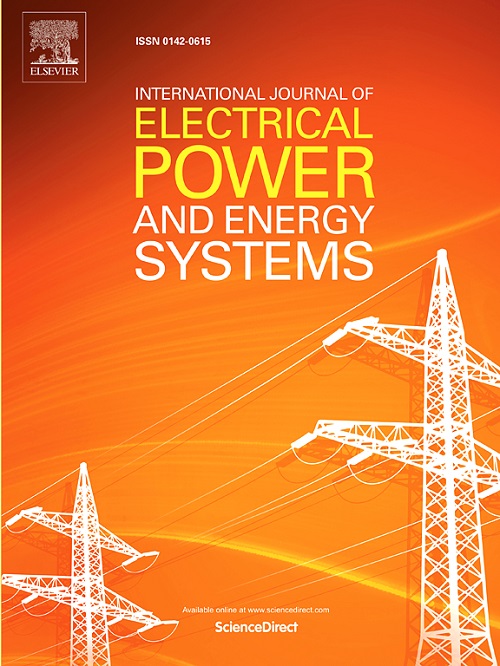机组承诺具有双向爬坡约束的柔性改造火电机组
IF 5
2区 工程技术
Q1 ENGINEERING, ELECTRICAL & ELECTRONIC
International Journal of Electrical Power & Energy Systems
Pub Date : 2025-05-03
DOI:10.1016/j.ijepes.2025.110709
引用次数: 0
摘要
火电机组柔性改造已广泛实施,以改善电力系统的平衡。这些改造使运行低于常规最小输出,称为深峰调节,以适应不断增加的可再生能源整合。由于火力发电机组的固有特性,爬坡率和爬坡率通常不同。现有的研究往往通过假设相同的爬坡率而忽略了这一差异。为了弥补这一差距,本文系统地建模和分析了单位承诺(UC)模型中的双向爬坡约束,为爬坡过程提供了更准确和现实的表示。具体而言,本文提出了三种创新的双向斜坡模型。第一种是全周期固定双向斜坡(AFBR)模型,该模型假设所有周期的斜坡速率恒定。第二个模型是周期间动态双向爬坡(InterDBR)模型,该模型捕获了不同调峰状态下爬坡速率的变化,包括带油深度调峰(DPRO)、深度调峰(DPR)和常规调峰(RPR)。这些爬坡率调整仅限于期间调度期间。三是周期内动态双向斜坡(IntraDBR)模型,该模型考虑了一个周期内调度周期内DPRO、DPR和RPR之间的过渡,从而反映了机组的实际运行情况。我们在IEEE 118总线系统和宁夏电网系统上验证了所提出的双向斜坡模型的有效性。结果表明,双向斜坡模型更准确有效地支持调度调度决策,提高了系统的安全性和经济性。本文章由计算机程序翻译,如有差异,请以英文原文为准。
Unit commitment with bidirectional ramping constraints of flexibility retrofit thermal power unit
Flexibility retrofits of thermal power units have been widely implemented to improve power system balancing. These retrofits enable operation below the regular minimum output, known as deep peak regulation, to accommodate increasing renewable energy integration. Due to the inherent characteristics of thermal power units, ramp-up rates and ramp-down rates generally differ. Existing studies often overlook this difference by assuming equal ramping rates. To bridge this gap, this paper systematically models and analyses bidirectional ramping constraints in unit commitment (UC) models, providing a more accurate and realistic representation of the ramping process. Specifically, this paper proposes three innovative bidirectional ramping models. The first is the all-period fixed bidirectional ramping (AFBR) model, which assumes a constant ramp rate across all periods. The second model is the interperiod dynamic bidirectional ramping (InterDBR) model, which captures variations in ramping rates across different peak regulation states, including deep peak regulation with oil (DPRO), deep peak regulation (DPR), and regular peak regulation (RPR). These ramping rate adjustments are restricted to interperiod scheduling periods. The third is the intraperiod dynamic bidirectional ramping (IntraDBR) model, which considers transitions between DPRO, DPR, and RPR within an intraperiod scheduling period, thereby reflecting actual operational conditions of the unit. We validate the effectiveness of the proposed bidirectional ramping models on the IEEE 118-bus system and a real-world Ningxia Power Grid system. Results demonstrate that bidirectional ramping models more accurately and effectively support dispatch scheduling decisions, improving system security and economic efficiency.
求助全文
通过发布文献求助,成功后即可免费获取论文全文。
去求助
来源期刊
CiteScore
12.10
自引率
17.30%
发文量
1022
审稿时长
51 days
期刊介绍:
The journal covers theoretical developments in electrical power and energy systems and their applications. The coverage embraces: generation and network planning; reliability; long and short term operation; expert systems; neural networks; object oriented systems; system control centres; database and information systems; stock and parameter estimation; system security and adequacy; network theory, modelling and computation; small and large system dynamics; dynamic model identification; on-line control including load and switching control; protection; distribution systems; energy economics; impact of non-conventional systems; and man-machine interfaces.
As well as original research papers, the journal publishes short contributions, book reviews and conference reports. All papers are peer-reviewed by at least two referees.

 求助内容:
求助内容: 应助结果提醒方式:
应助结果提醒方式:


